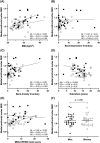Serotonergic and dopaminergic control of impulsivity in gambling disorder
- PMID: 36692875
- PMCID: PMC10078603
- DOI: 10.1111/adb.13264
Serotonergic and dopaminergic control of impulsivity in gambling disorder
Abstract
Gambling disorder (GD) is major public health issue. The disorder is often characterized by elevated impulsivity with evidence from analogous substance use disorders underlining prominent roles of brain monoamines in addiction susceptibility and outcome. Critically, GD allows the study of addiction mechanisms without the confounder of the effects of chronic substances. Here, we assessed the roles of striatal dopamine transporter binding and extrastriatal serotonin transporter binding in GD as a function of impulsivity using [123 I]FP-CIT SPECT imaging in 20 older adults with GD (DSM-5 criteria; mean age 64 years) and 40 non-GD age- and sex-matched controls. We focused on GD in older individuals because there are prominent age-related changes in neurotransmitter function and because there are no reported neuroimaging studies of GD in older adults. Volume-of-interest-based and voxelwise analyses were performed. GD patients scored clearly higher on impulsivity and had higher tracer binding in the ventromedial prefrontal cortex than controls (p < 0.001), likely reflecting serotonin transporter activity. The binding in the medial prefrontal cortex positively correlated with impulsivity over the whole sample (r = 0.62, p < 0.001) as well as separately in GD patients (r = 0.46, p = 0.04) and controls (r = 0.52, p < 0.001). Striatal tracer binding, reflecting dopamine transporter activity was also positively correlated with impulsivity but showed no group differences. These findings highlight the role of prefrontal serotonergic function in GD and impulsivity. They identify cerebral coordinates of a potential target for neuromodulation for both GD and high impulsivity, a core phenotypic dimensional cognitive marker in addictions.
Keywords: SPECT; gambling disorder; impulsivity.
© 2023 The Authors. Addiction Biology published by John Wiley & Sons Ltd on behalf of Society for the Study of Addiction.
Conflict of interest statement
There are no relevant conflicts of interest.
Figures




Similar articles
-
Striatal presynaptic dopaminergic dysfunction in gambling disorder: A 123 I-FP-CIT SPECT study.Addict Biol. 2019 Sep;24(5):1077-1086. doi: 10.1111/adb.12677. Epub 2018 Sep 18. Addict Biol. 2019. PMID: 30226290
-
Serotonin and dopamine transporter PET changes in the premotor phase of LRRK2 parkinsonism: cross-sectional studies.Lancet Neurol. 2017 May;16(5):351-359. doi: 10.1016/S1474-4422(17)30056-X. Epub 2017 Mar 20. Lancet Neurol. 2017. PMID: 28336296 Free PMC article.
-
Neuroimaging of reward mechanisms in Gambling disorder: an integrative review.Mol Psychiatry. 2019 May;24(5):674-693. doi: 10.1038/s41380-018-0230-2. Epub 2018 Sep 13. Mol Psychiatry. 2019. PMID: 30214041 Review.
-
Is gambling disorder associated with impulsivity traits measured by the UPPS-P and is this association moderated by sex and age?Compr Psychiatry. 2017 Jan;72:106-113. doi: 10.1016/j.comppsych.2016.10.005. Epub 2016 Oct 11. Compr Psychiatry. 2017. PMID: 27810546
-
Similarities and differences between pathological gambling and substance use disorders: a focus on impulsivity and compulsivity.Psychopharmacology (Berl). 2012 Jan;219(2):469-90. doi: 10.1007/s00213-011-2550-7. Epub 2011 Nov 5. Psychopharmacology (Berl). 2012. PMID: 22057662 Free PMC article. Review.
Cited by
-
Neurotransmitters crosstalk and regulation in the reward circuit of subjects with behavioral addiction.Front Psychiatry. 2025 Jan 14;15:1439727. doi: 10.3389/fpsyt.2024.1439727. eCollection 2024. Front Psychiatry. 2025. PMID: 39876994 Free PMC article. Review.
-
Brain-based graph-theoretical predictive modeling to map the trajectory of anhedonia, impulsivity, and hypomania from the human functional connectome.Neuropsychopharmacology. 2024 Jun;49(7):1162-1170. doi: 10.1038/s41386-024-01842-1. Epub 2024 Mar 13. Neuropsychopharmacology. 2024. PMID: 38480910 Free PMC article.
-
Frontal white and gray matter abnormality in gambling disorder: A multimodal MRI study.J Behav Addict. 2024 Jun 26;13(2):576-586. doi: 10.1556/2006.2024.00031. Print 2024 Jun 26. J Behav Addict. 2024. PMID: 38935433 Free PMC article.
-
The Association of Antidepressant Use and Impulse Control Disorder in Parkinson's Disease.Am J Geriatr Psychiatry. 2024 Jun;32(6):710-720. doi: 10.1016/j.jagp.2023.12.024. Epub 2024 Jan 3. Am J Geriatr Psychiatry. 2024. PMID: 38238235 Free PMC article.
-
Faecal microbiota composition and impulsivity in a cohort of older adults with metabolic syndrome.Sci Rep. 2024 Nov 14;14(1):28075. doi: 10.1038/s41598-024-78527-8. Sci Rep. 2024. PMID: 39543142 Free PMC article.
References
Publication types
MeSH terms
Substances
Grants and funding
LinkOut - more resources
Full Text Sources
Medical

